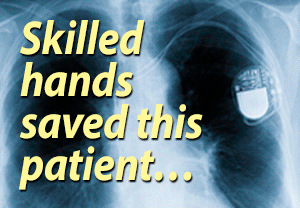 Anyone w. a pacer controlled by sinus node?
Anyone w. a pacer controlled by sinus node?
- by realkarl
- 2010-01-10 12:01:37
- Exercise & Sports
- 1642 views
- 5 comments
I am about to receive a biventricular PM (CRT-P), and as far as we know, my own sinus node is functioning well and beats normally. It is my understanding it will then set the pace almost all the time, but pacing both ventricles to make sure they beat in sync. I have a Left Bundle Branch Block, which is why I need the PM.
I am confused about what I read about advanced rate responsive PMs, and upper and lower limits. When the sinus node is sending out beats normally, it should be the most natural and best way to set the pace, right? Whereas my doctor confirmed my assumption, the St Jude rep confused me with what she said about limits and rate adjusting, but I don't think she knew my case yet.
One question I will ask my doctor tomorrow, is how does the PM override the natural beats, since they will still be going out? Will its pulse reach the ventricles before the natural pulse, thus activating the beat first? It seems clear it will do so for the left ventricle, but not so clear for the right ventricle, where there is no delay..
5 Comments
It's who gets there first
by pacemaker writer - 2010-01-10 07:01:33
The pacemaker's output pulse is not any "stronger" or more bossy than your heart's natural pulse. When it comes to which pulse controls the heart, it's the one that gets there first!
What happens if your pacemaker beats at exactly the split second your atria send out an output pulse? That can happen--it is called "fusion" or a "fused beat." It is considered completely harmless but it makes a weird-looking shape on the ECG.
Basically, it just means your heart got a double-dose of electrical energy (some from your heart and some from your pacer).
so if the pulses arrive at different times?
by realkarl - 2010-01-10 07:01:45
That's interesting, but then what happens with the pulse arriving later - is it just ignored, with no double heartbeat (I hope)? For instance, for my left ventricle, the natural pulse will always arrive after the one from the pacer, due to the LBBB, and for the right ventricle, they should get there almost the same time, but probably not all the time.
I can now see that it's very unlikely my heart rate monitor will work after I get the biventricular PM.
Rate Response
by ElectricFrank - 2010-01-10 11:01:21
You have the right idea about letting your own sinus response control the pacing rate. This is easily handled in the pacemaker by setting it to DDD mode. In this mode a sensing lead in the atrium pickups up its contraction and uses it to time the pacing pulse to the ventricles. There is no problem with conflicting paces because DDD mode turns off the rate response. (DDDR turns it on).
This is much better that using rate response if your sinus node is intact. Your heart rate responds in a much more natural way than with rate response. I've had mine set that way for 5 years and have hiked above 13,000' in Colorado without a hitch.
frank
CRT device
by golden_snitch - 2010-01-10 12:01:08
Hey there,
I'm not 100% sure, but I'll try to answer your questions:
If your sinus node is as you said functioning well, then it sets the rate, and you'll not need the rate responsive feature of the pacer. The pacer only tracks this rate and makes sure that both ventricles follow it. So, the pacer will not override the natural beats, it will still let the sinus node send out those signals. However, when your sinus node is not sending out impulses fast enough - when you should go into bradycardia - the pacer will also take over the sinus node's job in this regard.
Now, pacers have an upper tracking rate which means that they can only track the atrial rate and make the ventricles follow this rate up to a certain maximum rate. In my case it's 195 bpm. If my own atrial rhythm should ever go above that while being in heart block at the same time (no impulses travel from the atriums to the ventricles), the pacer can only make my ventricles beat at 195 bpm.
A friend of mine has a CRT device, too, and her sinus node is working well so she doesn't need the rate response. She once asked her EP if she even needs the atrial lead since she has no electrical problem in her atriums, and he said: she might not really, but CRT devices always have an atrial lead just to watch what's going on in the atriums. But technically he could turn it off and that shouldn't make her feel worse.
Hope this helps a bit.
Best wishes
Inga
You know you're wired when...
Your kids call you Cyborg.
Member Quotes
You now get to start a new life it's like being reborn.


.png)


Thanks!
by realkarl - 2010-01-10 01:01:08
That pretty much answers my question. With "override" I meant pulses sent at the same time as the natural pulses, but stronger such that the ventricles will respond to the pacer lead pulse instead of the pulse having traveled the normal way.
Before my valve problems and OHS to replace my aortic valve, and repair the mitral valve, I used to max out at 170 or so (I am 40), but after being put on beta blockers both before and after the OHS, I can't get much higher than 150. With the CRT I hope my EF will improve so much I can reduce some of this medication, and in addition to increased EF, also be able to increase my heart rate again at exercise, as well as get a lower resting pulse (it's too high now, due to low EF).